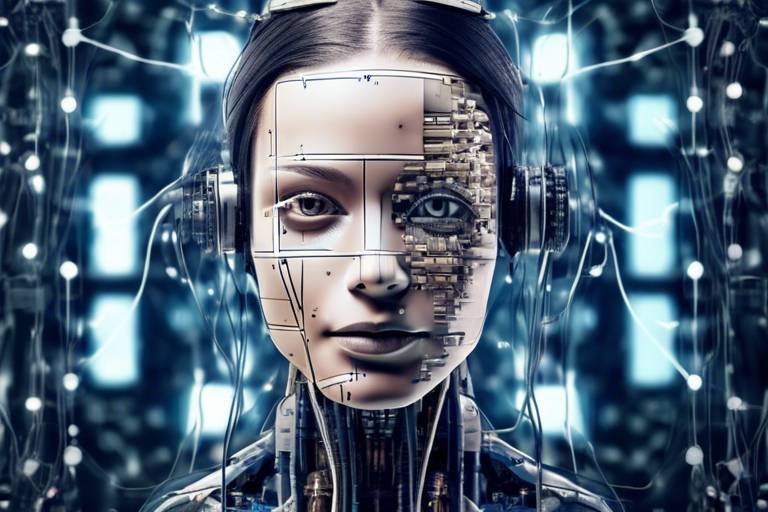AI Ethics: The Ongoing Journey for Justice
In our rapidly evolving world, artificial intelligence (AI) is not just a buzzword; it's a transformative force reshaping industries, economies, and our everyday lives. However, as we embrace the promise of AI, we must also grapple with the ethical implications that come along with it. The journey towards AI ethics is akin to navigating a winding road filled with both exciting opportunities and daunting challenges. This article delves into the complexities of AI ethics, examining the critical need for fairness, accountability, and transparency in AI systems. As we explore this ongoing journey, we will uncover the multifaceted layers of AI ethics and the collective responsibility we share in ensuring that technology serves humanity justly.
AI ethics encompasses the moral implications of AI technologies, focusing on their impact on society, privacy, and human rights. It aims to guide developers and users towards responsible AI deployment. Think of AI ethics as the compass that helps us navigate the uncharted waters of technology. Without it, we risk steering our society into treacherous territory where biases and injustices can proliferate. The ethical considerations surrounding AI are not just theoretical; they are practical concerns that affect real people every day. As we strive for innovation, we must also prioritize ethical standards that uphold human dignity and promote social good.
Fairness in AI is crucial to prevent discrimination and bias in decision-making processes. We live in a world where algorithms increasingly influence our lives, from hiring practices to loan approvals. If these algorithms are biased, the consequences can be devastating. Imagine applying for a job and being overlooked simply because the AI system favored candidates based on flawed data. This section discusses methodologies for assessing and enhancing fairness in AI algorithms, ensuring that technology serves as a level playing field rather than a tool of exclusion.
Bias identification involves scrutinizing data sets and algorithms to uncover hidden prejudices that could lead to unfair outcomes. Techniques for detecting bias are essential for ethical AI practices. One might wonder, how can we trust a system that operates behind closed doors? By shining a light on the inner workings of AI, we can expose biases that might otherwise remain hidden. This transparency is not just a luxury; it's a necessity for fostering trust in AI technologies.
The quality and diversity of data sources significantly influence AI behavior. Understanding how data selection affects outcomes is vital for promoting equity in AI systems. Just like a chef needs fresh ingredients to create a delicious dish, AI systems require high-quality data to yield fair results. If the data is skewed or unrepresentative, the AI will inevitably reflect those flaws. Therefore, it’s essential to prioritize diverse and representative data sources to ensure that AI serves all segments of society.
Transparency in algorithms allows stakeholders to understand decision-making processes. This section highlights the importance of open algorithms for fostering trust and accountability in AI applications. When algorithms are transparent, it’s easier to hold developers accountable for their creations. Imagine a world where you could peek inside the "black box" of AI systems and see how decisions are made. This level of transparency could empower users and promote ethical practices across the board.
Mitigation strategies are essential for addressing identified biases. This part covers techniques and best practices for developing fairer AI systems and reducing discriminatory impacts. It’s not enough to simply identify bias; we must actively work to eliminate it. This could involve implementing regular audits, using diverse teams in AI development, and employing algorithms that are specifically designed to minimize bias. The journey towards ethical AI is ongoing, and every step counts.
Accountability ensures that AI developers and organizations are responsible for the consequences of their technologies. This section explores frameworks for establishing accountability in AI systems. Just like a captain is responsible for their ship, AI developers must be held accountable for the technologies they create. Establishing clear accountability frameworks is essential for ensuring that ethical standards are upheld, and that any harm caused by AI can be addressed effectively.
Regulatory frameworks play a crucial role in guiding ethical AI development. This subsection discusses existing regulations and the need for comprehensive legal structures to govern AI technologies. As AI continues to evolve, so too must our regulations. We need robust legal structures that keep pace with technological advancements, ensuring that ethical considerations are woven into the very fabric of AI development.
Developers must adhere to ethical guidelines that prioritize human rights and societal well-being. This section outlines key principles for responsible AI development and implementation. By establishing a code of ethics for developers, we can create a shared understanding of the responsibilities that come with creating AI technologies. This is not just about compliance; it’s about cultivating a culture of ethical awareness that permeates every level of AI development.
Various stakeholders, including governments, corporations, and civil society, play a vital role in shaping AI ethics. This section examines collaborative efforts to promote ethical AI practices. Just as a symphony requires multiple instruments to create beautiful music, the journey towards ethical AI requires collaboration among diverse stakeholders. Each player brings unique perspectives and expertise, enriching the conversation around AI ethics.
Raising public awareness about AI ethics is essential for informed discourse. This subsection emphasizes the importance of education in fostering a culture of ethical AI use. Imagine a world where everyone understands the implications of AI technology. This level of awareness can empower individuals to advocate for ethical practices and hold organizations accountable. Educational initiatives are crucial for demystifying AI and promoting a culture of ethical engagement.
Collaborative initiatives among stakeholders can drive meaningful change in AI ethics. This part highlights successful partnerships aimed at addressing ethical challenges in AI development. By working together, stakeholders can share best practices, develop innovative solutions, and create a unified front in the battle for ethical AI. Collaboration is not just beneficial; it’s essential for navigating the complexities of AI ethics.
- What is AI ethics? AI ethics refers to the moral implications and responsibilities associated with the development and use of artificial intelligence technologies.
- Why is fairness important in AI? Fairness is crucial in AI to prevent discrimination and ensure that all individuals are treated equitably in decision-making processes.
- How can bias in AI be identified? Bias can be identified through techniques that scrutinize data sets and algorithms to uncover hidden prejudices.
- What role do stakeholders play in AI ethics? Stakeholders, including governments and civil society, collaborate to promote ethical practices and ensure accountability in AI development.
- How can we promote accountability in AI? Establishing regulatory frameworks and ethical guidelines for developers is essential for promoting accountability in AI technologies.

Understanding AI Ethics
AI ethics is a fascinating and complex field that dives deep into the moral implications of artificial intelligence technologies. At its core, it seeks to unravel the intricate web of how these technologies affect our society, privacy, and fundamental human rights. Imagine AI as a powerful tool that can either uplift communities or inadvertently reinforce existing inequalities. This duality is what makes understanding AI ethics so crucial. It’s not just about creating smarter machines; it’s about ensuring that these machines operate in a way that is fair, just, and beneficial for all.
In this ever-evolving landscape, AI ethics serves as a guiding light for developers and users alike, steering them towards responsible AI deployment. Think of it as a moral compass that helps navigate the murky waters of technology's impact on our lives. As we become more reliant on AI in areas like healthcare, finance, and law enforcement, the stakes get higher. The potential for misuse or bias can lead to significant societal repercussions, making it imperative for us to engage with these ethical considerations actively.
To put it simply, AI ethics is about asking the tough questions: Who is responsible when an AI makes a mistake? How do we ensure that AI systems do not perpetuate discrimination? And, what measures can we take to safeguard our privacy in an increasingly automated world? These questions are not just academic; they are essential for shaping the future of technology in a way that aligns with our shared values.
Furthermore, the dialogue surrounding AI ethics is not confined to technologists and policymakers alone. It involves a wide array of stakeholders, including ethicists, sociologists, and the general public. Each voice adds a unique perspective, enriching the conversation and leading to more comprehensive solutions. For instance, initiatives aimed at promoting ethical AI practices often rely on collaboration across sectors, emphasizing the importance of diverse input in shaping ethical standards.
As we delve deeper into the nuances of AI ethics, it becomes clear that this journey is ongoing. The landscape of technology is constantly shifting, and with it, the ethical challenges we face. Therefore, staying informed and engaged in discussions about AI ethics is not just beneficial; it is essential for anyone who interacts with these technologies. By fostering a culture of awareness and responsibility, we can ensure that AI serves as a force for good in our society.
In summary, understanding AI ethics is about more than just compliance; it's about cultivating a sense of responsibility and foresight. As we continue to innovate and integrate AI into our daily lives, let’s commit to ensuring that these advancements align with our ethical standards and contribute positively to society.

The Importance of Fairness
In the realm of artificial intelligence, fairness is not just a buzzword; it's a fundamental principle that shapes the way we interact with technology. Imagine a world where AI systems make decisions that affect our lives—like hiring, lending, or even law enforcement. If these systems are biased, the consequences can be devastating. Fairness in AI is crucial to prevent discrimination and bias in decision-making processes. It’s about ensuring that everyone, regardless of their background, has equal access to opportunities and is treated justly by algorithms that increasingly govern our daily lives.
To grasp the significance of fairness, we must delve into the methodologies that assess and enhance fairness in AI algorithms. These methodologies are essential for identifying potential biases that could skew outcomes against certain groups. For instance, a hiring algorithm that favors candidates from a specific demographic can perpetuate existing inequalities. Therefore, it is vital to implement rigorous testing and validation processes to ensure that AI systems operate fairly.
Identifying bias in AI is akin to peeling an onion; it requires layers of scrutiny. Bias identification involves examining data sets and algorithms for hidden prejudices that could lead to unfair outcomes. Techniques such as adversarial testing and fairness audits are essential in this process. By employing these techniques, developers can uncover and address biases before they translate into real-world repercussions.
The quality and diversity of data sources significantly influence AI behavior. Think of data as the fuel that powers AI systems; if the fuel is contaminated, the output will be flawed. When data sets lack diversity, they can lead to skewed results that disadvantage certain groups. For example, an AI trained primarily on data from one demographic may struggle to accurately assess individuals from other backgrounds. Understanding how data selection affects outcomes is vital for promoting equity in AI systems.
Transparency in algorithms is akin to having a clear window into a black box. It allows stakeholders—developers, users, and even regulators—to understand the decision-making processes behind AI systems. This transparency is crucial for fostering trust and accountability in AI applications. When stakeholders can see how decisions are made, they are more likely to feel confident in the technology. Moreover, open algorithms can facilitate collaboration among developers, leading to more ethical practices in AI.
Once biases have been identified, the next step is mitigation. Mitigation strategies are essential for addressing identified biases and ensuring that AI systems are fairer. Techniques such as re-sampling, re-weighting, and algorithmic adjustments can significantly reduce discriminatory impacts. By incorporating these best practices into the development process, we can create AI systems that not only function efficiently but also uphold the principles of fairness and justice.
In conclusion, the importance of fairness in AI cannot be overstated. As we continue to integrate AI technologies into various aspects of life, it is our responsibility to ensure that these systems operate without bias. By prioritizing fairness, we can create a more equitable future where technology serves all of humanity, not just a privileged few.
- What is AI fairness? AI fairness refers to the principle that AI systems should operate without bias, ensuring equal treatment for all individuals, regardless of their background.
- How can we identify bias in AI? Bias can be identified through techniques such as adversarial testing and fairness audits, which scrutinize data sets and algorithms for hidden prejudices.
- Why is algorithmic transparency important? Transparency allows stakeholders to understand how decisions are made by AI systems, fostering trust and accountability.
- What strategies can be used to mitigate bias? Strategies include re-sampling, re-weighting, and algorithmic adjustments to ensure fairer outcomes in AI systems.

Identifying Bias in AI
Identifying bias in AI is no easy feat; it's akin to searching for a needle in a haystack. Bias can lurk in the shadows of data sets and algorithms, subtly influencing outcomes in ways that may not be immediately apparent. But why is it so crucial to uncover these hidden prejudices? Because AI systems are increasingly making decisions that affect our lives, from hiring practices to loan approvals. If these systems are biased, they can perpetuate existing inequalities and create new ones.
To effectively identify bias, we must first understand the sources from which our data is drawn. Data sets often reflect historical inequalities, and if we’re not careful, we can inadvertently train AI systems on this flawed information. A common method for detecting bias involves statistical analysis, where developers scrutinize the data for disparities among different demographic groups. For example, if an AI model consistently favors one gender or ethnicity over another, it raises red flags that cannot be ignored.
Several techniques can be employed to detect bias in AI systems, including:
- Disparate Impact Analysis: This method examines whether a particular group is disproportionately affected by the AI's decisions.
- Fairness Metrics: Metrics such as equality of opportunity and predictive parity can quantify bias, providing a clearer picture of the AI's performance across different groups.
- Adversarial Testing: By using adversarial examples—data specifically designed to challenge the AI's decision-making—developers can uncover weaknesses and biases that may not be evident under normal conditions.
Moreover, the importance of transparency in the data selection process cannot be overstated. Developers must ask themselves critical questions like, "What data am I using?" and "Who collected this data?" Understanding the context and the potential biases embedded in the data is essential for ethical AI practices. If the data reflects societal biases, the AI will likely replicate those biases in its outputs. Thus, a thorough examination of data sources is paramount.
In summary, identifying bias in AI is a multi-faceted challenge that requires diligence, transparency, and a commitment to fairness. As we continue to integrate AI into various aspects of society, recognizing and addressing these biases will be vital in ensuring that AI serves as a tool for equity rather than a mechanism for discrimination.
- What is bias in AI? Bias in AI refers to systematic favoritism or prejudice in the decision-making process of AI systems, often arising from biased data or algorithms.
- How can we detect bias in AI? Bias can be detected through statistical analysis, disparate impact analysis, and fairness metrics, among other techniques.
- Why is it important to identify bias in AI? Identifying bias is crucial to prevent discriminatory practices that can have real-world consequences on individuals and communities.
- What role does data play in AI bias? The quality and diversity of data significantly influence AI behavior; biased data can lead to biased AI outcomes.

Data Sources and Their Impact
When it comes to artificial intelligence, the data sources we choose can be the difference between a groundbreaking innovation and a catastrophic failure. Think of data as the fuel that powers AI engines; without high-quality, diverse data, the results can be skewed and biased. The impact of data sources on AI behavior is profound, affecting everything from the accuracy of predictions to the ethical implications of decision-making. If we feed an AI system a diet of biased or incomplete data, it will inevitably produce biased results. This is akin to teaching a child with a limited worldview—if their experiences are narrow, their understanding of the world will be, too.
Moreover, the diversity of the data is just as important as its quality. A dataset that lacks representation from various demographics can lead to systems that are unjust and discriminatory. For instance, if an AI system designed for hiring is trained primarily on data from a specific gender or ethnicity, it may inadvertently favor candidates from that group, perpetuating existing inequalities. Therefore, it's crucial to ensure that data sources are not only accurate but also representative of the entire population.
To illustrate the significance of data sources, consider the following table:
| Data Source Type | Potential Impact | Examples |
|---|---|---|
| Public Datasets | Can provide a broad view but may lack diversity. | Government databases, health records |
| Private Datasets | Often rich in detail but may reflect company biases. | Corporate sales data, user behavior logs |
| Generated Datasets | Can fill gaps but may not reflect real-world complexities. | Simulated data, synthetic data generation |
In addition to diversity and quality, the **context** in which data is collected also plays a significant role. For example, data collected in one cultural or geographical setting may not be applicable in another. This raises the question: how can we ensure that AI systems are truly global in their understanding? The solution lies in a concerted effort to gather data from multiple sources and perspectives. By embracing a holistic approach to data collection, we can create AI systems that are not only more accurate but also more equitable.
Ultimately, the responsibility lies with developers and organizations to scrutinize their data sources meticulously. It’s essential to ask the right questions: Who collected this data? What biases might be present? How diverse is the dataset? By addressing these questions, we can pave the way for AI systems that are fair, transparent, and truly reflective of the society they serve.

Algorithmic Transparency
In the rapidly evolving landscape of artificial intelligence, has emerged as a critical pillar for fostering trust and accountability. Imagine you’re trying to solve a complex puzzle, but the pieces are hidden from view. This is essentially what happens when algorithms operate without transparency. Stakeholders—including users, developers, and regulators—need to understand not just the outputs of AI systems, but also the processes and reasoning behind those outputs. Without this clarity, how can we be sure that decisions made by AI are fair and unbiased?
One of the key challenges in achieving algorithmic transparency is the inherent complexity of many AI systems, particularly those based on machine learning. These systems often function as black boxes, where the decision-making process is obscured by layers of mathematical computations. To combat this opacity, various techniques have been developed to shed light on how algorithms operate. For instance, explainable AI (XAI) aims to make AI systems more interpretable by providing insights into how decisions are made. This not only enhances user understanding but also helps in identifying potential biases that may arise during the decision-making process.
Moreover, fostering algorithmic transparency goes beyond just technical solutions; it requires a cultural shift within organizations. Developers and AI practitioners must prioritize transparency as a core value in their work. This entails documenting the decision-making processes, openly sharing the data used in training models, and being willing to engage in discussions about the ethical implications of their technologies. For instance, companies can adopt transparency frameworks that outline their commitments to ethical AI practices. These frameworks can include:
- Regular audits of algorithms to ensure fairness and accountability.
- Publicly accessible documentation detailing how algorithms function.
- Feedback mechanisms for users to report concerns regarding AI decisions.
Furthermore, regulatory bodies are beginning to recognize the importance of transparency in AI. As governments around the world draft legislation to govern AI technologies, they are increasingly considering requirements for transparency. This includes mandates for organizations to disclose algorithmic decision-making criteria, especially in sectors like finance, healthcare, and law enforcement, where the stakes are particularly high. The goal is to create an environment where stakeholders can hold AI systems accountable, ensuring that they align with societal values and human rights.
In conclusion, algorithmic transparency is not just a technical requirement; it is a moral imperative for the responsible development of AI. By shining a light on the inner workings of algorithms, we can build trust among users and stakeholders, paving the way for a future where AI serves humanity equitably and justly. As we continue to navigate the complexities of AI ethics, let us remember that transparency is a vital step towards achieving fairness and accountability in these powerful technologies.
- What is algorithmic transparency?
Algorithmic transparency refers to the clarity and openness regarding how algorithms make decisions, allowing stakeholders to understand the processes behind AI outputs.
- Why is algorithmic transparency important?
It is crucial for building trust in AI systems, ensuring fairness, and enabling accountability among developers and organizations.
- How can organizations achieve algorithmic transparency?
Organizations can achieve transparency by documenting their algorithms, conducting regular audits, and engaging with users to address concerns.
- Are there regulations governing algorithmic transparency?
Yes, many governments are developing regulatory frameworks that require organizations to disclose information about their algorithms, especially in high-stakes areas.

Mitigating Bias
When it comes to in artificial intelligence, the journey is as intricate as a maze, filled with twists and turns that require careful navigation. Bias can sneak into AI systems through various channels, often hidden within the data or algorithms themselves. To tackle this pervasive issue, developers and organizations must adopt a multi-faceted approach that includes both proactive and reactive strategies. One effective method is to implement rigorous auditing processes that examine the data and algorithms used in AI systems. By regularly checking for biases, we can identify potential pitfalls before they lead to unfair outcomes.
Another vital strategy involves diversifying the data sources used to train AI models. Just as a well-balanced diet is essential for our health, a diverse dataset is crucial for creating fair AI systems. This means not only collecting data from a wide range of demographics but also ensuring that the data accurately represents the complexities of real-world scenarios. For example, if an AI system is designed to analyze job applications, it must include data from various socioeconomic backgrounds, genders, and ethnicities to avoid perpetuating existing disparities.
Moreover, employing algorithmic techniques specifically designed to reduce bias can also be beneficial. Techniques like adversarial debiasing and fair representation learning can help adjust algorithms to produce more equitable outcomes. These methods work by modifying the decision-making process of AI systems to ensure that they do not favor one group over another. It's a bit like tuning a musical instrument; just as you would adjust the strings to create harmony, these techniques help create a balanced output in AI systems.
To further emphasize the importance of these strategies, consider the following table that outlines common techniques for mitigating bias:
| Technique | Description | Benefits |
|---|---|---|
| Data Diversification | Using a wide range of data sources to train models | Reduces the risk of biased outcomes |
| Adversarial Debiasing | Adjusting algorithms to minimize bias during training | Promotes fairness in decision-making |
| Fair Representation Learning | Transforming data to ensure equitable representation | Enhances model accuracy across diverse groups |
Ultimately, mitigating bias is not just a technical challenge; it's a societal imperative. As AI continues to evolve, we must remain vigilant and proactive in addressing biases that could lead to discrimination. By fostering a culture of ethical responsibility and collaboration among developers, researchers, and stakeholders, we can create AI systems that not only perform well but also contribute positively to society. It's a collective effort, and every step taken towards fairness is a step towards a more just future.
- What is bias in AI? Bias in AI refers to systematic favoritism or prejudice that can arise in AI systems, often due to skewed data or flawed algorithms.
- How can bias be identified in AI systems? Bias can be identified through rigorous testing and auditing of data sets and algorithms, looking for patterns that indicate unfair treatment of certain groups.
- Why is mitigating bias important? Mitigating bias is crucial to ensure fairness, accountability, and transparency in AI systems, which ultimately affects societal trust in technology.
- What are some common techniques for mitigating bias? Common techniques include data diversification, adversarial debiasing, and fair representation learning.

Accountability in AI Development
Accountability in AI development is not just a buzzword; it’s a necessity. As artificial intelligence continues to permeate various sectors—from healthcare to finance—it's crucial that developers and organizations take responsibility for their creations. But what does accountability really mean in the context of AI? Simply put, it involves ensuring that the consequences of AI technologies are acknowledged and addressed. This means that when an AI system makes a mistake, the developers or organizations behind it should be held liable, just as they would be for any other product or service.
One of the main challenges in establishing accountability in AI development is the complexity of the technology itself. AI systems often operate as black boxes, where the decision-making process is not transparent. This obscurity can make it difficult to pinpoint where things went wrong when issues arise. To tackle this, it’s essential to implement frameworks that outline clear accountability structures. These frameworks should define who is responsible at various stages of AI development—from data collection and algorithm design to deployment and monitoring.
Moreover, organizations must adopt ethical guidelines that prioritize human rights and societal well-being. This includes ensuring that AI systems do not perpetuate harm or discrimination. For instance, when developing an AI model for hiring, it is imperative that the developers are aware of potential biases in the data and take steps to mitigate them. This proactive approach not only enhances the fairness of AI systems but also builds trust with users and stakeholders.
To illustrate the importance of accountability, consider the following table that outlines key elements of an effective accountability framework in AI development:
| Element | Description |
|---|---|
| Transparency | Clear communication about how AI systems operate and make decisions. |
| Responsibility | Identifying who is accountable for the outcomes of AI systems. |
| Regulation | Establishing legal frameworks to govern AI technologies and their usage. |
| Ethical Guidelines | Principles that guide developers in creating socially responsible AI. |
In addition to these elements, organizations should engage in regular audits of their AI systems to assess compliance with ethical standards and regulations. This proactive measure can help identify potential risks before they escalate into major issues. Furthermore, fostering a culture of accountability within organizations is vital. When team members understand the importance of ethical AI practices and are encouraged to voice concerns, it leads to better outcomes for everyone involved.
Ultimately, the journey towards accountability in AI development is ongoing. It requires collaboration among various stakeholders, including governments, corporations, and civil society. By working together, we can create a robust framework that not only holds developers accountable but also ensures that AI technologies serve the greater good.
- What is AI accountability? AI accountability refers to the responsibility developers and organizations have for the outcomes of their AI systems.
- Why is accountability important in AI? Accountability is crucial to ensure that AI technologies do not cause harm or perpetuate biases, and that there are consequences for failures.
- How can organizations ensure accountability? Organizations can ensure accountability by implementing transparent practices, adhering to ethical guidelines, and conducting regular audits of their AI systems.
- Who is responsible for AI decisions? The responsibility typically lies with the developers and organizations that create and deploy the AI systems.

Regulatory Frameworks
The landscape of artificial intelligence (AI) is constantly evolving, and with it, the need for robust that can effectively govern its development and deployment is becoming increasingly critical. As AI technologies permeate various aspects of our lives—from healthcare to finance, and even law enforcement—the potential for both positive impact and negative consequences grows. Thus, the establishment of comprehensive regulations is essential to ensure that AI serves the public good while minimizing risks.
Regulatory frameworks must address several key areas to be effective. First and foremost, they need to provide clear definitions of what constitutes ethical AI. This includes guidelines on data privacy, algorithmic accountability, and transparency. For instance, regulations should mandate that organizations disclose how their AI systems operate, including the data used in training these models. This transparency fosters trust between AI developers and the public, ensuring that users are aware of how decisions affecting their lives are made.
Moreover, these frameworks should promote collaboration among various stakeholders, including governments, tech companies, and civil society. By involving a diverse range of voices in the regulatory process, we can create a more equitable system that considers the needs and concerns of all affected parties. For example, public consultations can be held to gather input from community members and experts, ensuring that regulations are not only technically sound but also socially responsible.
To illustrate the importance of regulatory frameworks, consider the following table that outlines some existing regulations and their focus areas:
| Regulation | Focus Area | Region |
|---|---|---|
| GDPR | Data Protection | European Union |
| AI Act | Risk-based classification of AI systems | European Union |
| CCPA | Consumer Privacy Rights | California, USA |
| Algorithmic Accountability Act | Transparency in automated decision-making | USA |
Each of these regulations highlights the necessity of establishing guidelines that not only protect users but also hold developers accountable for their AI systems. However, it's crucial to recognize that regulations alone are not a panacea. They must be accompanied by a culture of ethical responsibility among developers. This means that organizations should not only comply with regulations but also strive to exceed them in their commitment to ethical AI practices.
As we look toward the future, the challenge lies in creating dynamic regulatory frameworks that can adapt to the rapid pace of technological advancement. This requires ongoing dialogue between regulators and the tech industry to ensure that regulations remain relevant and effective. By fostering a collaborative environment, we can pave the way for a future where AI is developed responsibly, with a strong emphasis on fairness, accountability, and transparency.
In conclusion, the establishment of robust regulatory frameworks is essential for governing AI technologies. These frameworks must prioritize transparency, collaboration, and ethical responsibility to ensure that AI serves the best interests of society. As we continue to navigate the complexities of AI ethics, it's imperative that we work together to create a regulatory landscape that promotes innovation while safeguarding human rights and societal well-being.
- What are regulatory frameworks in AI?
Regulatory frameworks are guidelines and rules established to govern the development and use of AI technologies, ensuring they are used ethically and responsibly. - Why are regulations important for AI?
Regulations help to mitigate risks associated with AI, such as bias and privacy violations, and promote transparency and accountability among developers. - How can stakeholders collaborate on AI ethics?
Stakeholders can collaborate through public consultations, partnerships, and shared initiatives aimed at promoting ethical AI practices.

Ethical Guidelines for Developers
In the rapidly evolving world of artificial intelligence, developers find themselves at the forefront of a significant ethical responsibility. With the power to shape technologies that affect millions of lives, it is imperative that developers adhere to a set of ethical guidelines designed to prioritize human rights, fairness, and societal well-being. But what exactly do these guidelines entail? Let's dive deeper.
First and foremost, developers should embrace the principle of transparency. This means that the processes and decisions made by AI systems should be understandable not just to fellow developers but also to the end-users. When users can comprehend how decisions are made, it fosters a sense of trust and accountability. Imagine using an AI system that helps you choose a healthcare plan; wouldn't you want to know how the recommendations are generated? Transparency helps demystify these processes.
Another crucial guideline is to prioritize fairness in AI algorithms. Developers must actively work to identify and mitigate biases in their models. This involves a thorough examination of training data, ensuring it is representative and diverse. For instance, if an AI system is trained predominantly on data from one demographic, it may inadvertently perpetuate stereotypes or exclude other groups. Therefore, developers should implement rigorous testing protocols to assess and enhance the fairness of their algorithms.
Moreover, developers should commit to ongoing education about ethical AI practices. The landscape of AI ethics is constantly changing, with new challenges emerging as technology advances. By staying informed about the latest ethical considerations, developers can better understand the implications of their work and adapt their practices accordingly. Participating in workshops, conferences, and online courses can be invaluable in this regard.
Additionally, collaboration is key. Developers should engage with stakeholders from various sectors—such as policymakers, ethicists, and community representatives—to gather diverse perspectives. This collaborative approach not only enriches the development process but also helps ensure that the AI systems created are aligned with societal values and norms. For example, when developing an AI tool for criminal justice, input from legal experts and community leaders can help identify potential ethical pitfalls.
Finally, accountability should be woven into the fabric of AI development. Developers must take responsibility for the outcomes of their systems. This means establishing clear lines of accountability within organizations and being prepared to address any negative impacts that arise from AI deployment. A culture of accountability encourages developers to think critically about the potential consequences of their work and motivates them to strive for solutions that are beneficial to society.
In conclusion, adhering to ethical guidelines is not just a checkbox for developers; it's a commitment to building a better future through responsible AI. By embracing transparency, fairness, ongoing education, collaboration, and accountability, developers can navigate the complexities of AI ethics and contribute positively to society. After all, in the grand tapestry of technology, every thread counts, and the choices made today will shape the world of tomorrow.
- What are the main ethical concerns in AI development? Ethical concerns include bias, transparency, accountability, and the impact on privacy and human rights.
- How can developers identify bias in AI systems? Developers can identify bias by analyzing training data for representation and conducting fairness assessments on their algorithms.
- Why is transparency important in AI? Transparency builds trust among users and stakeholders, allowing them to understand how decisions are made by AI systems.
- What role do stakeholders play in AI ethics? Stakeholders, including governments and civil society, help shape ethical practices and ensure that AI technologies align with societal values.

The Role of Stakeholders
In the intricate web of AI ethics, the role of stakeholders cannot be overstated. Various groups, including governments, corporations, civil society organizations, and the general public, all contribute to shaping the ethical landscape of artificial intelligence. Each stakeholder brings a unique perspective and set of responsibilities that are crucial for fostering an environment where AI technologies can thrive ethically. Think of it like a symphony; every musician must play their part harmoniously to create a beautiful piece of music. In this case, the music is a fair and accountable AI ecosystem.
Governments play a pivotal role in establishing regulations and policies that govern AI technologies. They have the power to enact laws that promote ethical practices and ensure that AI systems respect human rights and privacy. For example, data protection regulations like the General Data Protection Regulation (GDPR) have set a benchmark for how data should be handled, emphasizing transparency and user consent. By enforcing such regulations, governments can help mitigate the risks associated with AI misuse and discrimination.
On the other hand, corporations are the engines driving AI innovation. They have the responsibility to implement ethical guidelines in their development processes. This means integrating fairness, accountability, and transparency into their AI systems from the ground up. Companies like Google and Microsoft have established ethical AI teams to oversee their projects, ensuring that they align with societal values. However, it’s not just about compliance; it’s about cultivating a culture that prioritizes ethical considerations alongside technological advancement.
Civil society organizations also play a vital role in advocating for ethical AI practices. They often serve as watchdogs, holding corporations and governments accountable for their actions. By raising awareness of the potential harms of AI, these organizations can mobilize public opinion and influence policy changes. For instance, groups like the Electronic Frontier Foundation (EFF) work tirelessly to promote digital rights and ensure that AI technologies do not infringe upon individual freedoms.
Moreover, the general public must be included in this conversation. Public awareness about the implications of AI is essential for informed discourse and decision-making. When people understand how AI systems work and their potential impacts, they can engage more effectively in discussions about regulation and ethical standards. This is where education comes into play. Schools and universities should incorporate AI ethics into their curricula to prepare future generations to navigate the complexities of this technology responsibly.
To summarize, the collaboration among various stakeholders is crucial for advancing ethical AI practices. Each group has a distinct role, but together, they can drive meaningful change. Here’s a quick overview of the roles:
| Stakeholder | Role |
|---|---|
| Governments | Establish regulations and policies for ethical AI use |
| Corporations | Implement ethical guidelines and ensure responsible AI development |
| Civil Society | Advocate for accountability and raise awareness about AI ethics |
| Public | Engage in discussions and promote understanding of AI implications |
In conclusion, the journey toward ethical AI is a collective effort. By working together, stakeholders can create a robust framework that not only addresses current challenges but also anticipates future ethical dilemmas. The importance of collaboration cannot be understated; just as a single thread cannot weave a tapestry, no single stakeholder can ensure ethical AI practices alone. It requires a united front to navigate this evolving landscape responsibly.
- What is the role of governments in AI ethics? Governments establish regulations and policies that guide the ethical use of AI technologies.
- How can corporations ensure ethical AI development? Corporations can implement ethical guidelines and create oversight teams to align their projects with societal values.
- Why is public awareness important in AI ethics? Public awareness fosters informed discourse and encourages participation in discussions about AI regulations and ethical standards.
- What is the significance of civil society organizations? These organizations advocate for accountability and work to ensure that AI technologies respect human rights.

Public Awareness and Education
In today's fast-paced technological landscape, about AI ethics are more crucial than ever. As artificial intelligence continues to evolve and permeate various aspects of our lives—from healthcare to finance—it's essential for individuals to understand both the benefits and the potential risks associated with these technologies. But how do we foster this understanding? It starts with education.
Educational initiatives can take many forms, including workshops, online courses, and community discussions. These platforms serve as vital resources for demystifying AI technologies and their ethical implications. By engaging with the public, we can create a well-informed society that is not only aware of the opportunities AI presents but also vigilant about its challenges. For instance, schools and universities can incorporate AI ethics into their curriculums, ensuring that the next generation of developers and users is equipped with the necessary knowledge to navigate this complex landscape.
Moreover, raising awareness isn't just about formal education. It's about fostering a culture of curiosity and inquiry. When people are encouraged to ask questions like, "How does this AI system make decisions?" or "What data is being used and how?", they become active participants in the conversation surrounding AI ethics. This can lead to a more democratic approach to technology, where the voices of diverse communities are heard and considered in the development of AI systems.
To effectively spread awareness, we can leverage various channels:
- Social Media Campaigns: Platforms like Twitter, Instagram, and Facebook can be used to share informative content about AI ethics, reaching a broader audience.
- Public Forums: Hosting discussions and debates can provide a platform for people to express their concerns and insights regarding AI technologies.
- Partnerships with NGOs: Collaborating with non-governmental organizations can amplify efforts to educate the public about the ethical dimensions of AI.
Ultimately, public awareness and education act as a catalyst for change. They empower individuals to question and challenge AI systems, ensuring that developers are held accountable for their creations. As we move forward, it’s essential that we prioritize these initiatives, fostering a society that not only embraces technological advancements but also understands the responsibilities that come with them.
In addition to educational efforts, creating accessible resources—like guides and infographics—can help simplify complex AI concepts for the general public. By breaking down the intricacies of AI ethics into digestible pieces, we can make this crucial knowledge more approachable, paving the way for a more informed society.
As we continue to navigate this evolving landscape, let’s remember that the journey towards ethical AI is a collective one. Everyone has a role to play, and through awareness and education, we can ensure that the future of AI is not only innovative but also just and equitable.
Q1: Why is public awareness of AI ethics important?
A1: Public awareness is crucial because it empowers individuals to understand and engage with AI technologies, ensuring they are developed and used responsibly.
Q2: How can I get involved in AI ethics discussions?
A2: You can participate in local community forums, online discussions, or even social media campaigns focused on AI ethics to share your thoughts and learn from others.
Q3: Are there any educational resources available for learning about AI ethics?
A3: Yes, many universities and online platforms offer courses on AI ethics, and there are numerous books and articles available that discuss the topic in depth.
Q4: How can organizations promote awareness of AI ethics?
A4: Organizations can host workshops, create informative content, and collaborate with educational institutions to raise awareness about AI ethics among their employees and the public.

Collaborative Initiatives
In the rapidly evolving landscape of artificial intelligence, collaboration among various stakeholders is not just beneficial; it's essential. The challenges posed by AI ethics are complex and multifaceted, requiring a united front to navigate the murky waters of fairness, accountability, and transparency. Governments, corporations, academia, and civil society must work together to foster an environment where ethical AI practices can thrive. This collaboration takes many forms, from public-private partnerships to international coalitions aimed at setting standards for ethical AI development.
One of the most notable examples of such collaboration is the establishment of the Partnership on AI, which includes major tech companies, academic institutions, and non-profit organizations. This initiative aims to address the ethical implications of AI by sharing knowledge, conducting research, and promoting best practices. Through this partnership, stakeholders can pool their resources and expertise to tackle pressing ethical concerns, ensuring that AI technologies are developed responsibly.
Moreover, collaborative initiatives often focus on raising public awareness and encouraging education around AI ethics. For instance, organizations like the AI Now Institute conduct research and advocacy work that highlights the societal impacts of AI, engaging a wide audience in discussions about ethical practices. By fostering a culture of transparency and accountability, these initiatives help to demystify AI technologies and empower individuals to participate in the conversation about their implications.
In addition to these partnerships, collaborative efforts can also lead to the creation of frameworks and guidelines that promote ethical AI development. For example, the IEEE Global Initiative on Ethics of Autonomous and Intelligent Systems has brought together experts from various fields to develop standards that ensure AI systems are designed with ethical considerations in mind. This kind of initiative not only helps in creating a common language around AI ethics but also encourages organizations to adopt these standards in their development processes.
Ultimately, the success of these collaborative initiatives hinges on the active participation of all stakeholders. By working together, we can create a robust ecosystem that prioritizes ethical considerations in AI development. As the saying goes, "many hands make light work," and in the case of AI ethics, this couldn't be more true. The collective effort can lead to groundbreaking advancements that not only enhance technology but also safeguard human rights and societal well-being.
- What is the role of collaboration in AI ethics? Collaboration among stakeholders is crucial for addressing the complex challenges of AI ethics, ensuring diverse perspectives and expertise are brought together to develop responsible practices.
- How can public awareness contribute to ethical AI? Raising public awareness fosters informed discourse, encouraging individuals to engage with AI technologies and their implications, ultimately promoting a culture of ethical use.
- What are some examples of successful collaborative initiatives in AI ethics? Initiatives like the Partnership on AI and the IEEE Global Initiative on Ethics of Autonomous and Intelligent Systems exemplify successful collaborations aimed at promoting ethical practices in AI development.
Frequently Asked Questions
- What is AI ethics?
AI ethics refers to the moral implications and responsibilities surrounding the development and deployment of artificial intelligence technologies. It focuses on ensuring that AI systems operate fairly, transparently, and respect human rights. Essentially, it’s about making sure that as we create smarter machines, we don’t lose sight of our ethical compass.
- Why is fairness important in AI?
Fairness in AI is crucial to prevent discrimination and bias that can arise from flawed algorithms or biased data. If we don’t prioritize fairness, AI systems could perpetuate existing inequalities or create new ones. Think of it like a recipe; if you add the wrong ingredients, the dish won’t turn out right. In the same way, biased data can lead to unfair outcomes.
- How can we identify bias in AI systems?
Identifying bias involves a thorough examination of both the data and the algorithms used in AI systems. Techniques such as statistical analysis and audits can help uncover hidden prejudices. Just like a detective sifts through clues to solve a mystery, we need to scrutinize our AI systems to ensure they are fair and just.
- What role does data quality play in AI ethics?
The quality and diversity of data sources directly impact AI behavior. If the data is not representative or contains biases, the AI outcomes will reflect those flaws. It’s like trying to paint a picture with only one color; the result won’t be a true representation of reality. Thus, selecting high-quality, diverse data is vital for promoting equity in AI systems.
- What is algorithmic transparency and why is it important?
Algorithmic transparency means that the processes and decisions made by AI systems are clear and understandable to stakeholders. This is essential for building trust and accountability. If you think of AI like a magic show, transparency helps the audience understand how the tricks are done, making the experience more trustworthy and less mysterious.
- How can we mitigate bias in AI?
Mitigating bias requires implementing strategies like re-evaluating datasets, adjusting algorithms, and continuously monitoring outcomes. It’s similar to tuning a musical instrument; you need to make adjustments to ensure everything sounds just right. Regular checks and balances can help create fairer AI systems.
- What frameworks exist for AI accountability?
There are various regulatory frameworks that aim to guide ethical AI development, including guidelines from governments and organizations that stress the importance of accountability. These frameworks act like traffic signs on the road, helping developers navigate the complex landscape of AI ethics and ensuring they take responsibility for their creations.
- Why is public awareness about AI ethics important?
Public awareness is crucial for fostering informed discussions about AI and its implications. When people understand the ethical dimensions of AI, they can engage in meaningful conversations and advocate for responsible practices. It’s like shining a light in a dark room; knowledge helps illuminate the path forward.
- What collaborative initiatives are in place to promote ethical AI?
There are numerous collaborative initiatives involving governments, corporations, and civil society aimed at addressing ethical challenges in AI development. These partnerships can drive significant change, much like a team working together to build a strong structure. By pooling resources and expertise, stakeholders can create more ethical AI practices.



















